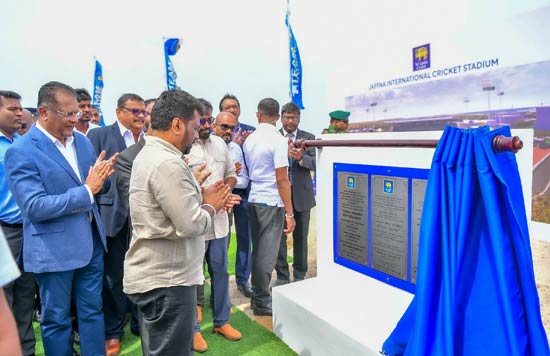Beyond Politics: Can cricket unite the North?
For Jaffna, a region long scarred by war and neglect, the promise of a state-of-the-art cricket ground feels like long overdue recognition. But beneath the ground-breaking ceremony and soaring rhetoric lies a familiar question–can Sri Lanka afford another expensive ‘white elephant’, or is this truly an investment into healing and development?
Cricket in Sri Lanka has always been more than just a sport. It is a cultural heartbeat, a unifier across class and creed. It is said that the LTTE leadership had made arrangements for the cadres and the Tamil refugee population to watch the 1996 World Cup final in jungle hideouts of the Wanni and other areas of the Jaffna district under their control. Such was cricket’s reach.

Sri Lanka’s north has endured decades of hardship. Even after the war ended in 2009, the physical, economic, and psychological scars remain. Infrastructure projects in Jaffna have too often been slow and politicised. For many Tamils in the peninsula, the sense of being treated as second-class citizens lingers, feeding resentment.
Already, signs of promise are visible. Vijayakanth Viyaskanth, the Jaffna leg-spinner who broke into Sri Lanka’s T20 side and even earned an IPL contract, has proven that talent can emerge from the north when opportunities are presented. Two other Jaffna boys, Kugathas Mathulan and Vigneshwaran Akash, currently represent Sri Lanka U-19s. A high-performance centre and turf wickets could multiply such stories in the region.
But this optimism must be checked against the country’s track record. The Sooriyawewa Hambantota International Cricket Stadium is a tale set in concrete. Initiated under the Rajapaksa regime’s attempt to make Hambantota the second capital, it was built in the middle of a jungle where elephants once roamed freely.
Officially valued at Rs. 852 million, its final bill was Rs. 4.2 billion, a staggering overspend accompanied by rumours of corruption. Today, that enormous building remains vacant, hardly hosting international games. It has not had a men’s international ODI in two years and a T20 international since 2013, even though some women’s international games and domestic games have been played. It is a monument to political ego, a reminder of the ways in which sport can be hijacked for ends far distant from grassroots needs.
This hangs over Jaffna, too. Do we run the risk of building another Hambantota, a costly symbol, underused, taking resources from where they are most needed? Five years ago, Sri Lanka Cricket (SLC) were planning to put up a similar stadium in Diyagama but a social media outcry led by former Sri Lanka cricketing greats forced its suspension.
They argued that those funds would be better spent on the development of the sport than dumped on costly infrastructure that would bring scant returns on investment. They insisted that efforts should be channelled towards constructing more turf wickets and improving infrastructure like swimming pools and indoor nets at existing venues. But there is no such outcry this time. This could be because they believe the people of the north deserve something better.
SLC has made bold pronouncements. A 40,000-seat international stadium with floodlights and facilities to match Pallekele or Dambulla is what they have promised. This, they say, is part of a broader vision to establish a Sports City in Jaffna, spanning 138 acres. Once completed, the Sports City will include a swimming pool complex, a multi-sport indoor arena, star-class hotels and restaurants, a shopping mall and entertainment facilities, amongst many others. Completion of the stadium is promised within three years, with officials confidently predicting hosting a domestic fixture by the end of the year. But the cost remains undisclosed.

This lack of transparency should be a concern for citizens. Sri Lanka, still recovering from its economic crisis, cannot afford to dump billions on mega-infrastructure projects. The memory of Hambantota’s overreach remains fresh, and until there are open accountability mechanisms, suspicion is warranted. It is not enough to build the stadium; maintaining it, ensuring it is not reduced to hosting the odd bilateral fixture every few years, or those domestic games requires vision and long-term planning.
Would a smaller, regionally appropriate facility not suffice? A stadium of the right size, accompanied by academies, coaching schemes, and school-level investment might bring much more grassroots benefit without the risk of financial ruin.
Aside from the figures, the initiative carries irresistible political connotations. The ceremonial laying of the foundation by President Anura Kumara Dissanayake as part of a portfolio of development projects in Jaffna was no accident. It positions the government as finally bringing long-deprived opportunity to the north, attempting to bridge decades of ethnic division through sport.
The symbolism is significant. For young Tamils, raised in the shadow of war and discrimination, to be able to step into a world-class stadium and belong to the same cricketing culture as boys in Kandy, Colombo or Galle could be revolutionary. Cricket can offer a sense of belonging, a place where Sri Lankan identity would outweigh ethnic distinctions.
But a stadium on its own cannot wash away the long-standing grievances of militarisation, contested land ownership, or economic exclusion in the north. Without matching investment in jobs, education, and reconciliation, the venture risks being dismissed as tokenism, a photo opportunity rather than a genuine step towards integration.
Sri Lankan cricket, too, has never truly reflected multiple identities. Tamil players have been chronically under-represented at the highest level, with only a dozen managing to break through.
That is why the new stadium stands as more than just concrete and steel; it is a test of intent. If given proper support, it could help foster a generation of cricketers from the north who, irrespective of ethnicity, see themselves not as outsiders but as an essential part of Sri Lanka’s sporting story. That would be reconciliation lived, not merely spoken.


